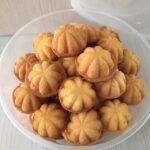Kuih Bahulu: The Perfect Cake to Go with Tea & Coffee
Kuih Bahulu, also known as Baulu or Bolu or 鸡蛋糕 (egg cake), is a cherished traditional Malay sponge cake that holds a special place in the hearts of Malaysians, particularly during festive seasons. This delightful cake shares a resemblance in concept to the famous French madeleine. Traditionally, Kuih Bahulu is baked in molds of various sizes and shapes. One of the most commonly found variations is the Bahulu Cermai, which features a charming star or flower shape, reminiscent of the local fruit Buah Cermai used in sambal belacan. Another beloved shape is the fish-shaped Bahulu Ikan.
Believed to have originated during the colonial era on the Malay Peninsula, the term “bahulu” likely derived from the Portuguese word “bolo,” meaning cake, particularly sponge cake. In Indonesia, this cake is known as Kue Bolu Kering, meaning “dry cake.”
Kuih Bahulu boasts a slightly crusty outer layer and a soft, tender interior. It possesses a mildly dry texture with a delicate sweetness. These attributes contribute to its extended shelf life, allowing it to be stored at room temperature for up to a month.
To prepare Kuih Bahulu, a batter is created using wheat flour, eggs, and sugar. Depending on the recipe and desired outcome, additional ingredients such as corn starch, baking powder, soda water, cream soda, vanilla essence, or salt may be included. To prevent the cake from sticking to the mould, the mould needs to be seasoned by coating it with oil (commonly cooking oil, coconut oil, or butter) and heating it until very hot. Once the mould is seasoned, the batter can be poured into it and baked until the Kuih Bahulu cakes turn a golden brown. Traditionally, these cakes were baked on hot sand heated by wood fire.
Over time, the recipe has adapted to suit modern Malaysian preferences and lifestyles. Today, Kuih Bahulu comes in a delightful array of flavours such as pandan, cappuccino, chocolate chips, strawberry, durian, green tea, and more.
Kuih Bahulu is commonly enjoyed during festivals such as Aidilfitri (Eid al-Fitr) and Chinese New Year, where it is served as a delectable snack for guests. It can be savoured either hot or cold, and its characteristic dryness makes it a perfect accompaniment to tea and coffee. Some individuals even enjoy dunking the cake into their beverages before indulging in its delightful flavours.





1 Response
[…] Kuih Akok also comes in many different shapes now. Most commonly found ones resemble tiny Kuih Bahulu. They also take on the shape of rectangles, and even blossom into exquisite flower-like patterns, […]